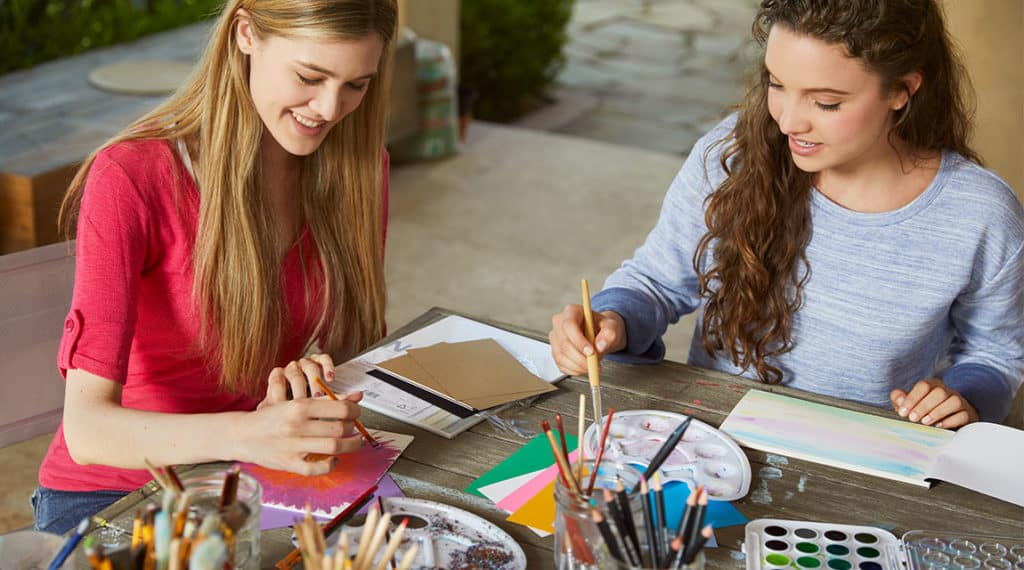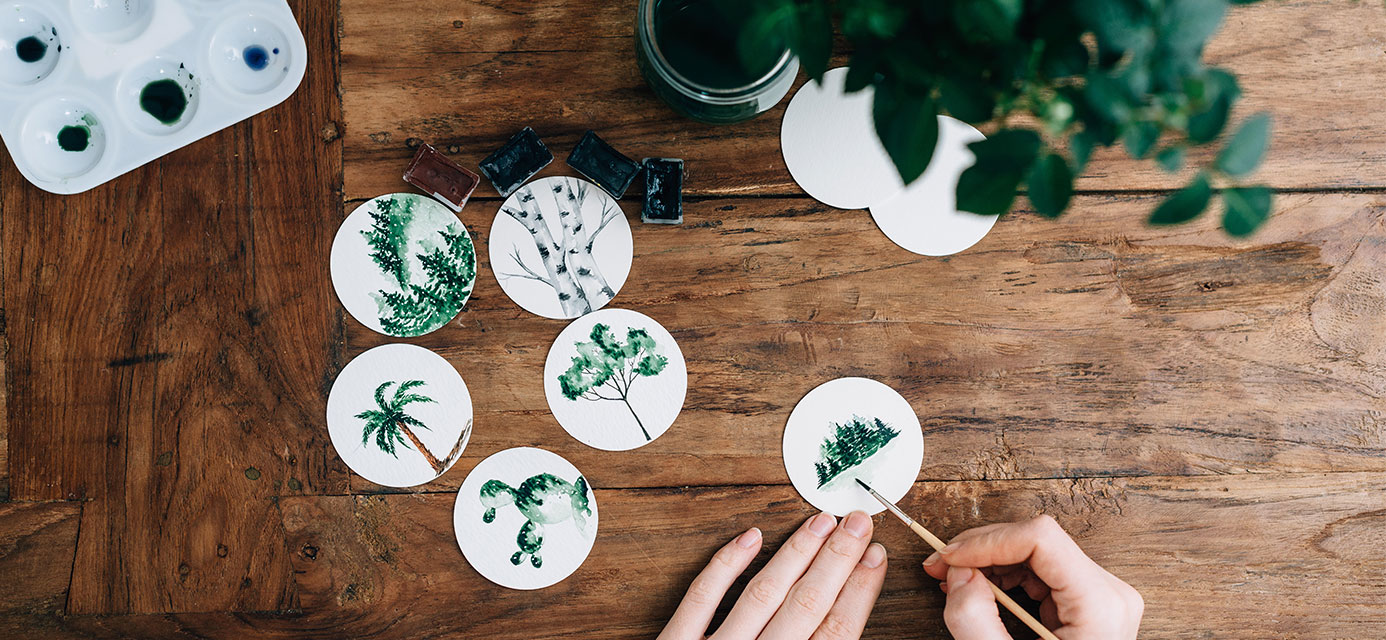Creativity and teen mental health go hand in hand. Creativity is part of building an identity. In addition, it supports brain development. Being creative even reduces anxiety. And, as a result, it makes us happier. Research proves that creativity and mental health are definitively linked.
Moreover, creative activities help teens build authentic connections with self and others. Consequently, they are better able to form positive relationships. Hence, creativity is a powerful tool for mental health recovery.
Authentic Connections, Creativity and Mental Health
“Expressing who we really are, without using words, leads to authentic connection with self,” says Kristin Wilson, MA, LPC, Vice President of Clinical Outreach at Newport Academy. “Once a teen feels connected with self—mind, body, and spirit—they can more easily connect with family and peers.”
Kristin holds a master’s degree in creative arts therapies. She offers a workshop on creativity as part of Rethinking Teen Mental Health: A Path to Sustainable Healing, Newport Academy’s innovative adolescent mental health conference series.
The creativity and mental health workshop provides new research on the adolescent brain. In particular, Kristin focuses on the development of the prefrontal cortex. Furthermore, she addresses the importance of creative expression during adolescence.
“Creativity supports an adolescent’s ‘job’ of finding their identity, establishing their beliefs, and questioning authority.”
—Kristin Wilson, MA, LPC

Creativity and Adolescent Brain Development
The act of doing something creative employs various parts of the brain:
- The default mode network (the “resting” brain state) generates ideas.
- The salience network helps to identify which ideas get passed along to the executive control network for consideration.
- Next, the executive control network evaluates ideas, directs attention, and oversees decisions and choices.
That’s why being creative enhances connectivity in the brain. Connectivity refers to the relationships between different areas of the brain. For example, a review study published in 2014 suggests that people with musical training have improved connectivity between the two hemispheres of their brains.
Moreover, creativity helps teens develop what’s known as divergent thinking. Divergent thinking is a process of generating creative ideas by exploring many possible solutions.
The Benefits of Creative Hobbies
For many, hobbies provide access to creativity. One recent study looked at the mental health impact of leisure time spent on hobbies and self-selected pursuits.
The researchers found that healthy leisure activities generate the following effects:
- More positive mood
- Greater feelings of interest
- Reduced stress
- Lower heart rate.
Therefore, researchers theorize that leisure activities evoke the nervous system’s relaxation response. As a result, hobbies improve mental health.
In addition, boredom and disengagement have been linked to poor health behaviors. This includes drug and alcohol use, smoking, and unhealthy eating. Hence, leisure activities may serve as protective factors.

The Element of Flow in Teen Creativity and Mental Health
Furthermore, creative pursuits provide what psychologist Mihaly Csikszentmihalyi calls “flow.” He uses the term “flow” to describe the experience of being absorbed in an activity. Subsequently, in a study of American adolescents, Csikszentmihalyi and Jeremy P. Hunter discover that teens are happier during flow experiences.
“Teenagers ascribe ‘happiness’ to their moods when they are … able to engage in flow activities that stretch their skills and makes them feel alive and proud,” the researchers conclude.
As a result, experiences of flow are the key to happiness. And creativity, in particular, produces flow. Moreover, unplugged creative activities for teenagers offer both flow and a mini digital detox.
“For this generation of teenagers who spend a lot of time in front of screens, creative pursuits provide a way to be grounded in the moment,” says Kristin Wilson. “In addition, creativity can give teens a feeling of mastery.”

Happiness, Creativity and Mental Health
Older studies suggest a link between creativity and mental illness. However, new research indicates the opposite may be true.
In fact, a study found that people who practice a creative activity once a day are happier than those who don’t. And it doesn’t matter how skillful they are. Even if they don’t excel at what they’re doing, they still experience the benefits of creativity.
The study involved 658 university students. They kept a diary for 13 days. Each day, they reported how much time they spent on creative activities. Moreover, they reported on their emotional state on each of the 13 days.
Hence, the diaries prove that adolescents engaged in creative activities feel more enthusiastic. Furthermore, they experience a greater sense of flourishing following creative days. Moreover, this sense of well-being catalyzed more creative activity.
Thus, the researchers describe this as an “upward spiral for well-being and creativity.” These findings support “everyday creativity as a means of cultivating positive psychological functioning.”
Creativity Combats Anxiety
Another study of university students examines the psychological effects of making art. One week before final exams, 57 participants were randomly assigned to either an art-making group or a control group. Art-making activities included painting or coloring pre-designed mandalas, free-form painting, collage making, still life drawing, and modeling with clay.
Before and after the study, the students’ anxiety levels were tested with the State-Trait Anxiety Inventory. The art-making group experienced a decrease in anxiety following the activity.
Hence, even a brief time spent doing creative activities can reduce anxiety. Moreover, this has implications for art and art therapy programs designed to help college students and others cope with stress.

How Arts Therapy Activates Creativity and Mental Health
Creative arts therapies activate many mechanisms. Moreover, they provide alternative routes for self-expression. This is helpful for teens who feel uncomfortable with talk therapy or find verbal expression difficult.
“Teens know the buzzwords, and the talk therapy process can be impacted by that,” says Kristin. “The creative process doesn’t allow for that kind of manipulation to happen.”
Therapeutic modalities using art, music, and dance enhance the connections between mental health and creativity. Creative arts therapies—including music and visual art interventions—are proven to be effective for teens. They go beyond words. Furthermore, they go beyond the rational mind, tapping into our most authentic self.
In summary, creativity both prevents and helps reverse mental health struggles. And this is important during adolescence. Teens are at high risk for depression and anxiety. Also, the teen brain is wired for creativity. Consequently, creative expression is a natural fit to support thriving in adolescents.
Images courtesy of unsplash
Sources:
Ann Behav Med. 2015 Aug;49(4):605–15.
Brain Sci. 2014;4(2):405–427.
J Pos Psych. 2018;13(2).
New Directions Child & Adolescent Dev. 2016;151:73–84.






